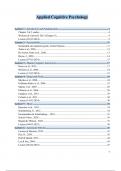Applied Cognitive Psychology
Lecture 1 - Introduction and Fundamentals................................................................................... 4
Chapter 2 & 3 reader..................................................................................................................4
Wickens & Carswell, 2012 (Chapter 5)..................................................................................... 4
Lecture (05-02-2024)................................................................................................................. 9
Lecture 2 - Sustainability.............................................................................................................. 11
Sustainable development goals, United Nations......................................................................11
Tsalis et al., 2020..................................................................................................................... 12
De Freitas Netto et al., 2020.................................................................................................... 13
Beyne, J., 2020.........................................................................................................................14
Lecture (07-02-2024)............................................................................................................... 15
Lecture 3 - Human Computer Interaction.................................................................................... 17
Preece et al., 2015.................................................................................................................... 17
Wickens et al., 2004.................................................................................................................18
Lecture (12-02-2024)............................................................................................................... 21
Lecture 4 - Drugs and Food......................................................................................................... 24
Miyake et al., 2000...................................................................................................................24
Goldman-Rakic et al., 2000..................................................................................................... 25
Mattay et al., 2003................................................................................................................... 26
Fillmore et al., 2006................................................................................................................. 28
Jongkees et al., 2015................................................................................................................ 29
Colzato et al., 2013.................................................................................................................. 30
Lecture (14-02-2024)............................................................................................................... 30
Lecture 5 - Music.......................................................................................................................... 34
Rauscher et al., 1993................................................................................................................34
Schellenberg, E., 2012............................................................................................................. 34
Swaminathan & Schellenberg ., 2019......................................................................................35
Sala & Gobet., 2020.................................................................................................................36
Bigand & Tillman., 2022......................................................................................................... 37
Lecture (04-03-2023)............................................................................................................... 38
Lecture 6 - Automated Vehicles.................................................................................................... 41
Carsten & Martens, 2019......................................................................................................... 41
Dey, D., 2020........................................................................................................................... 42
Hoff & Bashir, 2015.................................................................................................................44
Lee & See, 2004.......................................................................................................................45
Lecture (06-04-2023)............................................................................................................... 47
1
,Lecture 7 - Attention and Distraction........................................................................................... 49
Lopez et al., 2016.....................................................................................................................49
Schmidt, S.J., 2020.................................................................................................................. 50
Theeuwes, J., 1992...................................................................................................................51
Warm et al., 2008..................................................................................................................... 52
Wolfe & Horowitz., 2017.........................................................................................................52
Lecture 7 (25-04-2023)............................................................................................................ 54
https://app.mindmup.com/map/_free/2024/03/a0248a70e84911ee8d85cb9ada1a5225
2
,3
, Lecture 1
Introduction and fundamentals
Chapter 2 & 3 reader
Scope of applied cognitive psychology : the application of fundamental knowledge of cognitive
psychology to almost all aspects of every-day modern life.
The assumption of ACP is that in any system which includes human users in a certain
environment, the outcome is always a result of the interaction between the cognitive and physical
functioning of the users and the particular characteristics of the environment.
The model below also shows factors and indicators. Indicators allow us to evaluate the quality of
the interaction between the user and the environment, and assess to what degree goals are being
met. On the left, you also see factors, which refers to any intervention, manipulation, or method,
meant to affect or change the cognitions or environment.
The domain in which such a model is applied (education, healthcare, etc) can inform the set of
goals and the constraints related to implementing certain factors.
Wickens & Carswell, 2012 (Chapter 5)
Why was the study done: As we take in information, we must transform it in our brains to process
it and give “feedback” to it. This can often be the source of error. Because of this, the study aims
to grasp a better understanding of different stages of information processing.
Three approaches to information processing:
● The stage approach
4
, The most well known stage approach was proposed by Broadbent, which suggested that
sensory information needs to pass a filter before having someone attend to it. As the
name states, the stage approach would be the idea that information passes through stages
whilst being manipulated.
● The ecological approach
Contrary to the stage approach, the ecological approach puts much greater emphasis on
the integrated flow of information rather than separate state sequences, with an integrated
interaction with the environment. In this approach, action and perception are closely
linked.
● Cognitive engineering/Cognitive ergonomics
This approach can be seen as a combination of the stage approach and ecological
approach. Like the ecological approach, it puts emphasis on the thorough understanding
of the environment. On the other hand, it also puts a lot of focus on the knowledge
structure that the operator (person) has to transform and use the input.
All in all, actions generally produce feedback that complete a closed-loop cycle.
Selecting information:
● Selective attention can be described as the influence of four different factors; salience,
expectancy, value, and effort. These can be represented by the SEEV Visual Attention
Model: P(A) = S − EF + EX × V, which predicts what in the environment is attended to.
Good design should try to reduce these four components to two by making valuable
information sources salient (correlating salience and value) and by minimizing the effort
required to access valuable and frequently used (expected) sources.
● Focused attention deals with maintaining the attention where it is. The primary sources
of breakdowns in focused attention are certain physical properties of the visual
environment (clutter) or the auditory environment (noise), which will nearly guarantee
some processing of those environments, whether or not such processing is desired. This
can be seen as a distraction.
● Discrimination and confusability
Making sources discriminable by space, color, intensity, frequency, or other physical
differences has two benefits; (1) allows operators to divide the world into meaningful
components and (2) makes it easier to maintain attention on one stimuli and ignore
distraction from another.
● Visual search
This is also looking for something in a cluttered environment. It is a form of top-down
processing. The simplest model of visual search, based on a serial self-terminating
search, assumes that a search space is filled with items most of which are non-targets or
distractors. Factors that can influence visual search are pre-existing knowledge of the
operator, expectancy, and learning.
5





